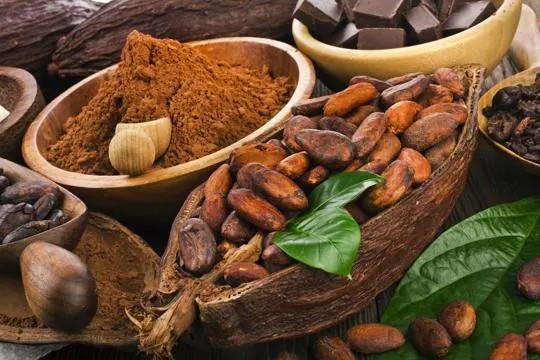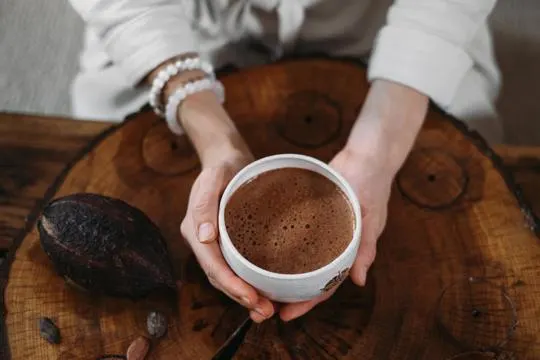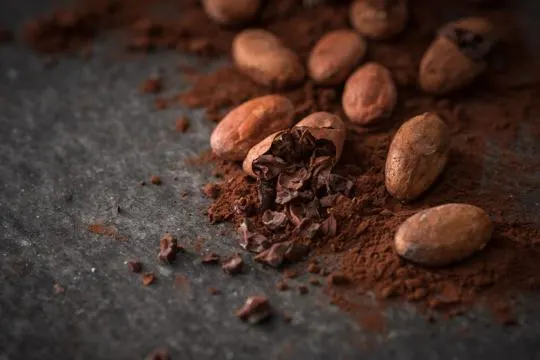Summary of key points
The main difference between cacao, cocoa, and carob lies in their source and processing methods. Cacao refers to the beans that come from the cacao tree and are used to make chocolate. These beans are fermented, dried, roasted, and ground into a paste which is then used to make various chocolate products. Cocoa is made from ground cacao beans that have been processed at high temperatures, resulting in a smoother and less bitter taste. Carob, on the other hand, comes from the pods of the carob tree and is often used as a substitute for chocolate due to its similar appearance and texture. However, it has a naturally sweet taste and does not contain caffeine like cacao and cocoa do.
Cacao, Cocoa, or Carob. Ever stood in the aisle of a grocery store, scratching your head? We’ve all been there.
Today, we’re tackling the trio head-on. Cacao? It’s the raw deal, straight from the tree. Cocoa? That’s cacao’s roasted, pulverized cousin. And Carob? It’s the sweet, earthy alternative rocking the health food scene.
Here’s a scoop from us. Ever tried making brownies and found yourself in a pickle over which to use? We’ve done that more times than we’d like to admit. Mixing them up can lead to some… interesting culinary experiments.
Each has its place in our kitchens (and hearts). By the end, you’ll know your stuff. We promise, no more aisle confusion.
Understanding Cacao, Cocoa, and Carob

Cacao, cocoa, and carob are three products that look similar, but are quite distinct.
Knowing the differences between them can help you choose the right ingredient for your recipes.
Cacao is the purest form of chocolate. It comes from the seeds of the cacao tree.
Fermentation, drying, roasting, and grinding turn the seeds into a fine powder.
It’s packed with antioxidants and nutrients.
Cacao tastes bitter and is great for baking or making hot drinks.
Cocoa is made from cacao beans that have gone through higher temperature processing.
This reduces the bitterness and gives it a smoother flavor.
Cocoa powder is widely available in stores and is often used for hot chocolate or baking.
Carob isn’t from the same family of plants.
Carob pods are gathered from trees and ground into powder.
It tastes sweet and is sometimes used as a substitute for chocolate in recipes.
It also has health benefits, such as being high in fiber.
In short, each of these ingredients has its own unique characteristics.
Depending on your personal taste or dietary needs, you can decide which one to use.
So, make sure to keep this in mind when you’re choosing ingredients or enjoying a sweet treat.
Differences Between Cacao, Cocoa, and Carob

Cacao, cocoa, and carob may sound similar, but they are not the same.
Origin and Plant Source
Cacao, cocoa, and carob are three distinct plants.
Cacao is sourced from tropical regions of America.
Cocoa is derived from the cacao plant.
Carob, on the other hand, is harvested from the Mediterranean region.
Cacao trees thrive in humid climates, well-drained soil, and rainfall.
The pods of the cacao tree grow on the trunk or branches.
The beans are harvested, fermented, and dried.
They are then processed into nibs, powder, and butter.
Cocoa is produced by roasting, grinding, and pressing cacao beans.
This process creates a more refined flavor compared to raw cacao.
Cocoa is commonly used in baking and chocolate production.
Carob comes from a different plant species.
Carob trees bear elongated pods with seeds and sweet pulp.
The pods are ground into a powder similar to cocoa, but carob has its own distinct flavor.
Cacao, cocoa, and carob are all unique ingredients.
Understanding the differences between them is helpful when choosing ingredients for cooking.
Processing and Production
Processing and production are critical for cacao, cocoa, and carob.
Start with harvesting pods from trees, then fermentation to make flavors.
Afterwards, beans must be dried to preserve aroma.
They get ground into cocoa mass or liquor.
To go further, the cocoa mass is pressed to separate cocoa butter.
The cake then becomes cocoa powder or other forms, such as Dutch-processed cocoa.
Conching is also key in chocolate production.
This is heating and stirring the chocolate mass to make it smoother and tastier.
It’s essential to understand these two words: cacao and cocoa.
Cacao is usually raw or minimally processed, with more nutrients.
Cocoa is usually roasted at high temperatures, which makes it more familiar but with fewer nutrients.
Carob is an alternative to the two. It’s made from grinding carob pods into powder or making carob chips.
Processing and production are vital for the final product.
All three – cacao, cocoa, and carob – have taste and nutrition affected by these methods.
Knowing this lets us enjoy them better.
Flavor Profiles
Cacao, cocoa, and carob are three different ingredients – each with its own unique flavor.
Cacao has a deep, rich chocolate taste. Cocoa is slightly less intense.
And carob offers a milder, sweeter flavor.
Cacao’s flavor profile is characterized by its strong chocolate essence.
It has deep undertones and a bitter-sweet taste.
Cacao adds complexity to desserts like cakes, cookies, and brownies.
You can also savor it in hot chocolate or even as a dusting on cappuccinos.
Cocoa shares similarities with cacao, but it’s generally less intense.
It still gives a delicious chocolate experience that enhances muffins, puddings, and other baked goods.
The mellow yet satisfying flavor of cocoa pairs with other ingredients without overpowering them.
Carob stands out with its sweeter profile.
It’s perfect for sweet treats like candies or ice cream toppings – with its naturally mild and caramel-like taste.
It also has subtle nutty undertones, making it great for spreads or a substitute for traditional chocolate.
In conclusion, each of these ingredients brings something special to the kitchen.
Knowing their differences allows for creativity and exciting possibilities for culinary experimentation.
Nutritional Composition
Cacao, cocoa, and carob are three distinct substances.
They have similarities but also differences in their nutrition.
Knowing these variations is important for people who want to make healthy diet choices.
Cacao is well-known for its flavor and health advantages.
It is full of nutrients, including flavonols (antioxidants).
These may help reduce the risk of heart disease and improve brain function.
Cacao is also a great source of iron, magnesium, and potassium.
Cocoa is the processed form of cacao.
It is made by roasting and grinding cacao beans into a powder.
Cocoa still has some of the nutrition from raw cacao, but the antioxidants may be reduced through processing.
Nonetheless, cocoa is still rich in vitamins and minerals, like calcium.
Finally, carob is a caffeine-free substitute for chocolate.
It is often used in baking or as an ingredient in candy.
Carob is lower in fat and higher in fiber than cacao and cocoa.
It has calcium and potassium too.
In conclusion, cacao, cocoa, and carob all have different nutritional qualities.
Cacao is high in antioxidants and other compounds.
Cocoa is processed, so some of its nutrition is lost.
Carob is lower in fat and higher in fiber.
Everyone can choose what fits their tastes and needs.
Similarities and Common Uses

Cacao, cocoa, and carob are all culinary favorites.
They share similarities in terms of being used as ingredients in various dishes.
Cacao provides a deep chocolate flavor, commonly used to make chocolate bars, hot cocoa drinks, and baked goods.
It’s also a key ingredient in creating ganache or mousse.
It can even be used in savory dishes like mole sauce.
Cocoa is processed at high temperatures, giving it a milder flavor than cacao.
Cocoa powder is often used in baking to enhance the richness of desserts.
Carob is an alternative for those who prefer a less intense chocolate taste or have dietary restrictions.
It has a sweet, milk chocolate-like flavor without the caffeine or theobromine of cacao or cocoa.
Carob powder can replace cocoa powder in recipes like cakes, cookies, or hot drinks.
Comparing Cacao, Cocoa, and Carob in Culinary Applications

Cacao, cocoa, and carob are ingredients used in cooking.
Each has special qualities that make it perfect for different uses.
Cacao is the purest form of chocolate and has a strong taste.
It is good for baking dark chocolates and desserts.
The fat content makes it creamy.
Cocoa is made by roasting the beans at high temperatures.
This lessens the bitterness and makes it sweeter.
Commonly used in baking recipes, like cakes and hot chocolate.
Its texture mixes easily with other ingredients.
Carob is an alternative to chocolate for those with allergies or dietary restrictions.
It does not have caffeine or theobromine.
Carob has a sweet taste with a nutty flavor.
Can be used in recipes like cookies, smoothies, and ice cream.
Cacao and cocoa come from the same source but different processing gives them different flavors and textures.
Carob adds a unique taste.
Cacao, Cocoa, or Carob: Which One to Choose?
Cacao, cocoa, and carob are all options if looking for a natural and healthy alternative to chocolate.
Each has unique flavors and benefits, making the decision tough.
Knowing the differences can help to select the perfect one for your tastes and needs.
Cacao is referred to as pure chocolate.
It is made from raw cacao beans, minimally processed.
It has a strong flavor, some say it’s slightly bitter.
It contains antioxidants and minerals like magnesium, iron, and zinc.
It also has mood-boosting compounds.
Cocoa is made by roasting cacao beans at high temperatures before grinding them into a powder.
It has a milder taste compared to cacao.
It’s often used in baking and desserts, as it blends well with other ingredients.
It still has health benefits but may have lower levels of nutrients than cacao.
Carob is sometimes used as a chocolate substitute due to its sweet flavor.
It does not contain caffeine or theobromine, so it’s suitable for those sensitive to these stimulants.
The powder is made from carob pods and can be used in recipes.
When selecting one of these, consider personal preferences and dietary needs.
Cacao has bold flavors and health benefits.
Cocoa has a milder taste and nutrition.
Carob provides a sweet flavor without stimulants.
Exploring Lesser-Known Uses and Benefits
Uncover a world of possibilities with cacao, cocoa, and carob.
Discover their unique flavor profiles and potential health benefits.
Cacao, the raw form of chocolate, is full of antioxidants and nutrients that support brain and heart health.
Cocoa is the processed version – milder in flavor, yet similar benefits.
Carob is a caffeine-free alternative, naturally sweet and derived from carob tree pods.
These ingredients have been linked to improved mood, reduced stress, better heart health, and improved digestion.
Plus, carob contains high levels of calcium for stronger bones.
Conclusion
After examining the primary differences between cacao, cocoa, and carob, it is evident that each of these ingredients has unique flavors, textures, and uses.
Cacao is the pure form of chocolate, while cocoa includes ingredients like sugar and milk fat.
Carob is a substitute for cocoa and has nutty and slightly sweet notes to its taste.
Though one may be more prevalent than the other in certain recipes, all three are valuable components in many different dishes.
In essence, determining which one to use depends on personal preference or what best complements a particular recipe.
Whatever choice you make when deciding among cacao, cocoa or carob, just know that your dish will be full of richness and flavor.

Leave a comment